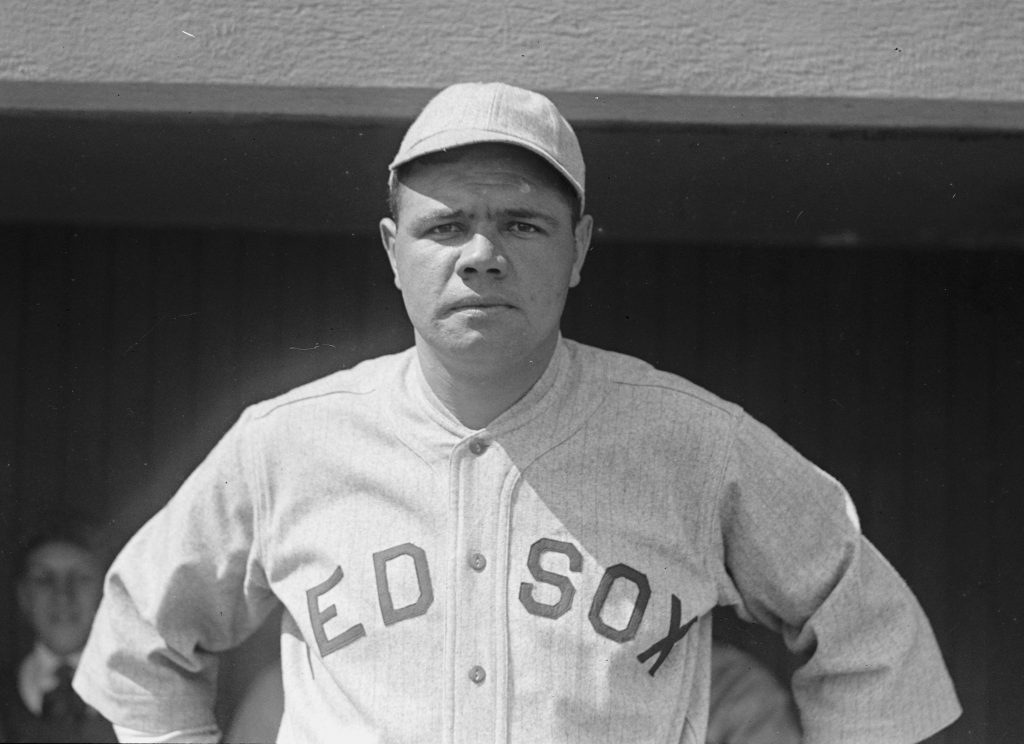The Great Bambino, The Babe, Sultan of Swat, The Big Fellow—you’ve probably heard of him. Babe Ruth, one of the greatest baseball players to ever live, was born George Herman Ruth Jr. in Pigtown, Maryland and was the son of Katherine Schamberger and George Ruth Herman Sr. Babe was known to be a rowdy child. It is rumored that the Babe threw tomatoes at police officers while they were hard at work. Due to his constant trouble making, Babe’s parents sent him off to St. Mary’s Industrial School in Baltimore, Maryland, where The Babe fell in love with baseball. Brother Mathias taught Babe how to throw, catch, and hit while he was at St. Mary’s; Mathias was a brother in the Catholic Church who taught children at St. Mary’s. Not after long, the Babe became an incredible ball player with the help of Brother Mathias, and later went on to play for the Boston Red Sox. What? You thought he played for the Yankees, right? He did, but his career began with the Boston Red Sox.1 Babe Ruth began his first season on the Red Sox in July of 1914. The Babe became a star, hitting twenty-nine home runs in the 1919 season with the Red Sox.2

Now this is where something terrible happens… Red Sox owner, Harry Frazee, sells the best player on the team to their rivals, the Yankees. In addition to being the Red Sox owner, Frazee was also a Broadway producer, and he used the money he made from selling Babe Ruth to produce one of his plays. Babe Ruth was worth a lot of money; in fact, the Red Sox sold him for $125,000! But the money did not even go back into the organization. Frazee continued this broken baseball business while selling Boston’s finest talent up until 1921, when he sold the Red Sox to Ed Barrow.2 This created the longest, most brutal curse in baseball history. Getting rid of your best players, selling them to your rival team, and receiving tons of money for a Broadway play… now that is just asking for a curse. As soon as Babe Ruth left the Red Sox things began to turn sour for the Red Sox organization. Babe Ruth was playing the best baseball of his life for the Yankees, and the Red Sox were certainly not winning games without him.4 Red Sox fans became disgusted with the organization, and the team lost many of its supporters over time.
Losing became a bad habit that the Red Sox could not seem to shake. In 1986, the Curse of the Great Bambino dramatically broke the hearts of all Red Sox fans. That year the Red Sox finally made it to the World Series, after almost seventy years. Playing against the New York Mets, the Red Sox overcame all statistical predictions and went on the play a remarkable series. In Game 6, the game went into extra innings. In the top of the tenth inning, Boston scored two runs, bringing them into the lead. With two outs against them, the Red Sox were one out away from being the World Series Champions. Suddenly, the Mets got two singles, bringing the tying runner to third. The Red Sox manager pulled pitcher Roger Clemens, and brought in their best closer, Bob Stanley, to finish the game.2 The count was 2-2 when Stanley threw a wild pitch, allowing the tying run to score and advance the other runners on base. The next pitch Stanley threw ended up being a weak ground ball hit to the first baseman, Bill Buckner.6 It was a routine play that Buckner, who was very consistent, missed… the ball went right through his legs, causing the winning run to score. If you’ve ever heard the phrase “pull a Buckner,” now you know what that means! The Red Sox lost Game 6, and they had been only two strikes away from winning the World Series; a greater force seemed to be holding the Red Sox back from winning the 1986 World Series. The Red Sox then lost Game 7 against the Mets, which was blamed on the curse.7 Game 7 was determined a loss in every fan’s eyes after the fifth inning, when the Mets secured their lead with a two-run homerun. Red Sox fans began to think that the curse was more real than ever. They were one pitch away from winning a world series, and one pitch away from ending sixty-eight years of frustration.8 The losing continued, and subsequent seasons only got worse.
Eighteen years later, in the 2004 season, the Red Sox started to show promise again. They started winning.2 The 2004 team eventually made it to the American League Championship Series against the Yankees. This time the Red Sox had one of the best teams in its history. Everyone on this team played their part in this series. The first three games of the series were discouraging for Red Sox fans, for the Red Sox lost to the Yankees all three times, allowing them only one more game to win to go onto the World Series. Many of the Red Sox players started motivating others by saying “don’t let us win at 8 tonight, if they let us win tonight we have Pedro Martinez coming in hot tomorrow,” “if there is a group of idiots that can do it, it’s us.”2 The Red Sox did not make this series easy on themselves, and they refused to get swept by their rivals. Game 4, bottom of the 9th inning, down by a run, Kevin Millar gets walked, allowing the Red Sox one last chance to beat the Yankees. The Red Sox put a pinch runner in for Millar, Dave Roberts, one of the speediest guys on the team, in order for him to steal second. Roberts almost got picked off twice, but finally stole second. He was safe!2 Red Sox fans began believing in their team. The next batter hits a line drive up the middle, scoring Roberts and tying up the game 4-4. Now to extra innings. Big Papi, David Ortiz, comes up in the bottom of the 12th inning and hits a walk-off homer!2 The Red Sox beat all odds, and finally win Game 4. But the Series is never over until it is truly over. The Red Sox were determined to win the next three games in order to prove the world wrong. In Game 5, the Yankees start out strong, leading the game by 2 runs, but then, in the bottom of the 8th inning, Big Papi steps up to the plate, once again hits a bomb over the tremendous green monster, resulting in the Red Sox being only down by one run.13 The Red Sox later tie up the game in the bottom of the 8th inning. The curse started to show its power in the top of the 9th inning, when the Yankees began hitting, the Red Sox were making errors, and the baseball gods were not in their favor. Luckily, the Red Sox made it out of the top of the 9th inning scoreless. Heading in to the bottom of the 9th Big Papi again steps up to plate hitting a line drive walk off to center field.2 David Ortiz has now come in clutch this series in dire need, twice! The baseball gods seem to finally be working in favor of the Red Sox, leading them to Game 6—Game 6 was one of the most passionate baseball games ever played.

The Red Sox continued their series slogan “why not us” in order to motivate their fans and players.2 Curt Schilling, who had just received an ankle surgery, was on the mound tonight, giving all Red Sox fans the inspiration to persevere through these last two games. Schilling fed off of the hatred of the Yankee fans, and started out very strong. Schilling did his job as a pitcher, and the offense was hitting for their injured pitcher, leading 4-0. Later throughout Game 6, Schilling’s sock became soaked in blood, and his ankle was starting to fester.2 Schilling began to limp back to the dugout, and he finished the 7th inning strong and was then pulled. Schilling made history that night, pitching with an injured bloody ankle. He left Yankee stadium shocked, and Red Sox fans inspired. The baseball gods were back and helping the Red Sox with controversial calls. The Red Sox go on winning Game 6 due to the heroic performance of Curt Schilling. His passion for the game was shown that night in Yankee Stadium.2
Finally, going into Game 7, the final game of the series, it was anybody’s ball game. Big Papi yet again brings the Red Sox into a lead 2-0 due to a major long ball home-run. In the 2nd inning, Johnny Damon hits a grand slam over the centerfield wall, allowing the Red Sox to have a 6-run security cushion early in the game.2 In the bottom of the 6th inning, the Red Sox put in pitcher Pedro Martinez, and Yankee fans began to shout, “who’s your daddy?” in order to taunt Martinez. Martinez pushed through the negativity, and finished the game 8-1 as American League Champions!2 This was the first time in sports history for a baseball team to come back to win a three-game deficit. Now off to the World Series against the St. Louis Cardinals, winning in an easy four games, finally ending the curse of the Great Bambino, after eighty-six years.

- Cynthia Rose, The Babe Ruth Story (Detroit: Gale, 2004), 692-694. ↵
- St. James Encyclopedia of Popular Culture, 2013, s.v. “Boston Red Sox,” by Steve Meyer. ↵
- St. James Encyclopedia of Popular Culture, 2013, s.v. “Boston Red Sox,” by Steve Meyer. ↵
- Edward M. Scahill, “Did Babe Ruth Have a Comparative Advantage as a Pitcher?,” The Journal of Economic Education, no. 4 (Autumn 1990): 404. ↵
- St. James Encyclopedia of Popular Culture, 2013, s.v. “Boston Red Sox,” by Steve Meyer. ↵
- Cynthia Rose, They Were Just One Pitch Away (Detroit: Gale, 2004), 642. ↵
- Cynthia Rose, They Were Just One Pitch Away (Detroit: Gale, 2004), 644. ↵
- Cynthia Rose, They Were Just One Pitch Away (Detroit: Gale, 2004), 645. ↵
- St. James Encyclopedia of Popular Culture, 2013, s.v. “Boston Red Sox,” by Steve Meyer. ↵
- St. James Encyclopedia of Popular Culture, 2013, s.v. “Boston Red Sox,” by Steve Meyer. ↵
- St. James Encyclopedia of Popular Culture, 2013, s.v. “Boston Red Sox,” by Steve Meyer. ↵
- St. James Encyclopedia of Popular Culture, 2013, s.v. “Boston Red Sox,” by Steve Meyer. ↵
- The green monster is a unique green wall in left field that is significantly taller than all of the other parts of the fence, and very few players are able to hit over this incredibly tall wall. ↵
- St. James Encyclopedia of Popular Culture, 2013, s.v. “Boston Red Sox,” by Steve Meyer. ↵
- St. James Encyclopedia of Popular Culture, 2013, s.v. “Boston Red Sox,” by Steve Meyer. ↵
- St. James Encyclopedia of Popular Culture, 2013, s.v. “Boston Red Sox,” by Steve Meyer. ↵
- St. James Encyclopedia of Popular Culture, 2013, s.v. “Boston Red Sox,” by Steve Meyer. ↵
- St. James Encyclopedia of Popular Culture, 2013, s.v. “Boston Red Sox,” by Steve Meyer. ↵
- St. James Encyclopedia of Popular Culture, 2013, s.v. “Boston Red Sox,” by Steve Meyer. ↵




58 comments
Megan Barnett
I liked your introduction as I found it kind of funny to realize how many different nicknames Babe Ruth had. When you mentioned about the Red Sox trading him it didn’t really surprise me because I feel that in most famous baseball player stories they are traded sooner or later. I also liked your word choice as you described the games and made them stand out more.
Dayna Valdez
The article gave me a better understanding of how the curse began and was eventually broken. I was surprised on how long it took for them to do so, however was amazed on how much perseverance they had throughout the games. While reading this article I also got a better image of several of the games and how hard the players worked to break the curse. Overall, very interesting and great article!
Richard Navarro
Interesting to hear about Babe Ruth. I never knew his story about his younger life. Its amazing to see someone turn their anger or problems into something great. I can’t believe that the manager of the Red Sox actually sold Babe Ruth to the Yankees just to produce his play! That is ridiculous. However, its not the curse that grabbed my attention because I am not a Sox fan. But Babe Ruth’s beginning story was incredible!
Clarissa Bustamante
I absolutely LOVE the sport of baseball so anything that has the involvement of it automatically has my attention. I think you did such a great job portraying the Curse and the situations the Red Sox had to overcome to get to achieve their final goal which was to regain the support and belief of their fans and also to when the World’s Series Championship. This article was amazing I really felt like I was a part of the many events that occurred.
Andrew Rodriguez
I am not much of a baseball fan but I have read 3 baseball articles and its the most history rich sport out there. I remember hearing the great bambino in the sandlot movie. Just like that kid I didn’t know who he was either. This guy was sold by his old team for money just like a quick flip in real estate. But boy did he make them pay, by going to have one spectacular career in New York. But luckily for the Red Sox the curse was broken, so has the curse of the Chicago Cubs
Amanda Figueroa
This article told the story of the curse in great detail and was very well written and kept my attention throughout. I have never seen a baseball game and have only heard of Babe Ruth. This story taught me a lot that I did not know, but am well informed now. I wonder how Babe Ruth felt when being sold to the rivalry team just for the money. This must have been really hard for the Red Sox, but I’m glad the curse is over.
Tara Sellers
This article is about how the Red Sox’s “curse” stared. I wonder if the fact that the Yankees took their best player Babe Ruth made their rivalry more intense. I knew the Red Sox went a long time without winning the World Series but I didn’t realize how long exactly. This article was very informative on how the Red Sox ended their curse and how the curse had come to be.
Michael Mandujano
Awesome another baseball article to comment on, I guess you can say I am a baseball fanatic. This article was very interesting and allowed me to gain a greater understanding of this curse. Overall, I enjoyed the depictions of the Great Bambino, or Babe Ruth. I also liked how this article incorporated personal background knowledge of the Great Bambino. In fact, I am glad the Boston Red Sox eventually broke the curse.
Thomas Fraire
I absolutely love baseball, and am one of the biggest Yankees fans ever. This article was amazing, it referred to the baseball gods and aspects of the game only baseball players or diehard fans would understand. This article was captivating and really interesting in enjoyed it a lot. I love how it tells a team’s history and how long this curse followed the Red Sox’s and their strive for success.
Ashley Tumlinson
I am a HUGE Red Sox fan. I absolutely loved your article – it was so well written and even though I knew about most of the things discussed I kept reading because it was that good! As an athlete, I can relate to the whole concept of superstition and ‘curses’. Although admittedly it can get out of hand at times, for some athletes it’s actually calming because to us it’s not ‘superstition’ but simply a routine. Anyway, your article portrayed this Sox curse perfectly! Great job!!